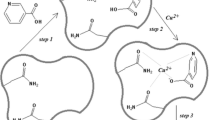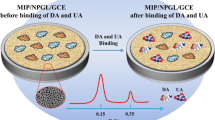Abstract
Synthesis of creatinine-imprinted polymer is challenging because of its insolubility in aprotic solvents, traditionally utilized for synthesizing molecularly imprinted polymer (MIP). Moreover, creatinine is not electroactive at conventional electrodes, and thus, introducing an electrochemical sensing platform for its determination is a difficult target. This study addressed the above-cited issues to introduce a novel creatinine voltammetric sensor with high selectivity and sensitivity. Creatinine-copper complex was found to be soluble in acetonitrile and was utilized as a template for the MIP synthesis. Methacrylic acid, ethylene glycol dimethacrylate, and azobisisobutyronitrile were used as functional monomers, cross-linker, and initiator, respectively. The MIP holding creatinine sites were used to modify the carbon paste electrode. Since creatinine did not exhibit a significant voltammetric signal, an indirect sensing technique was employed. This was based on using Cu(II) ion as an electrochemical probe. The MIP-modified electrode signal for copper ion was significantly improved in the presence of creatinine. However, the introduction of creatinine in the Cu(II) solution did not affect the NIP-modified electrode response to copper ion. The proposed sensor indicated a linear current response in the range 1 × 10−7–1 × 10−5 mol L−1 with a detection limit of 5.9 × 10−8 mol L−1 (S/N = 3). Moreover, this method presents excellent performance in real sample analysis, with values of favorable creatinine recovery in plasma. The system exhibits acceptable precision (RSD = 4.04) and favorable selectivity toward creatinine.
Graphical abstract







Similar content being viewed by others
References
Narayanan Sh, Appleton HD (1980) Creatinine: a review. Clin Chem 26(8):1119–1126
Toffaletti JG, McDonnell EH (2008) Variation of serum creatinine, cystatin C, and creatinine clearance tests in persons with normal renal function. Clin Chim Acta 395(1–2):115–119
Herget-Rosenthal S, Bökenkamp A, Hofmann W (2007) How to estimate GFR-serum creatinine, serum cystatin C or equations? Clin Biochem 40(3–4):153–161
Slot C (1965) Plasma creatinine determination a new and specific Jaffe reaction method. Scand J Clin Lab Invest 17(4):381–387
Husdan H, Rapoport A (1968) Estimation of creatinine by the Jaffe reaction: a comparison of three methods. Clin Chem 14(3):222–238
Mohabbati-Kalejahi E, Azimirad V, Bahrami M, Ganbari A (2012) A review on creatinine measurement techniques. Talanta 97:1–8
Lewińska I, Speichert M, Granica M, Tymecki Ł (2021) Colorimetric point-of-care paper-based sensors for urinary creatinine with smartphone readout. Sens Actuators, B Chem 340:129915
Tsuchida T, Yoda K (1983) Multi-enzyme membrane electrodes for determination of creatinine and creatine in serum. Clin Chem 29(1):51–55
Osaka T, Komaba S, Amano A (1998) Highly sensitive microbiosensor for creatinine based on the combination of inactive polypyrrole with polyion complexes. J Electrochem Soc 145(2):406
Kim EJ, Haruyama T, Yanagida Y, Kobatake E, Aizawa M (1999) Disposable creatinine sensor based on thick-film hydrogen peroxide electrode system. Anal Chim Acta 394(2–3):225–231
Killard AJ, Smyth MR (2000) Creatinine biosensors: principles and designs. Trends Biotechnol 18(10):433–437
Randviir EP, Banks CE (2013) Analytical methods for quantifying creatinine within biological media. Sens Actuators, B Chem 183:239–252
Chen J-C, Kumar AS, Chung H-H, Chien S-H, Kuo M-C, Zen J-M (2006) An enzymeless electrochemical sensor for the selective determination of creatinine in human urine. Sensors Actuators B: Chem 115(1):473–480
Raveendran J, Resmi PE, Ramachandran T, Nair B G, Satheesh Babu TG (2017) Fabrication of a disposable non-enzymatic electrochemical creatinine sensor. Sensors Actuators B: Chem 243:589–595
Chen C-H, Lin MS (2012) A novel structural specific creatinine sensing scheme for the determination of the urine creatinine. Biosens Bioelectron 31(1):90–94
Viswanath KB, Devasenathipathy R, Wang S-F, Vasantha VS (2017) A new route for the enzymeless trace level detection of creatinine based on reduced graphene oxide/silver nanocomposite biosensor. Electroanalysis 29(2):559–565
de Araújo WR, Salles MO, Paixão TRLC (2012) Development of an enzymeless electroanalytical method for the indirect detection of creatinine in urine samples. Sensors Actuators B: Chem 173:847–851
Li T-J, Chen P-Y, Nien P-C, Lin C-Y, Vittal R, Ling T-R, Ho K-C (2012) Preparation of a novel molecularly imprinted polymer by the sol–gel process for sensing creatinine. Anal Chim Acta 711:83–90
Akhoundian M, Alizadeh T, Pan G (2020) Fabrication of the enzyme-less voltammetric bilirubin sensor based on sol-gel imprinted polymer. Electroanalysis 32(3):479–488
Alizadeh T, Nayeri S, Mirzaee S (2019) A high performance potentiometric sensor for lactic acid determination based on molecularly imprinted polymer/MWCNTs/PVC nanocomposite film covered carbon rod electrode. Talanta 192:103–111
Tarannum N, Hendrickson OD, Khatoon S, Zherdev AV, Dzantiev BB (2020) Molecularly imprinted polymers as receptors for assays of antibiotics. Crit Rev Anal Chem 50(4):291–310
Alizadeh T, Nayeri S (2020) An enzyme-free sensing platform based on molecularly imprinted polymer/MWCNT composite for sub-micromolar-level determination of pyruvic acid as a cancer biomarker. Anal Bioanal Chem 412(3):657–667
Yan H, Row KH (2006) Characteristic and synthetic approach of molecularly imprinted polymer. Int J Mol Sci 7(5):155–178
Alizadeh T, Atashi F, Ganjali MR (2019) Molecularly imprinted polymer nano-sphere/multi-walled carbon nanotube coated glassy carbon electrode as an ultra-sensitive voltammetric sensor for picomolar level determination of RDX. Talanta 194:415–421
Saylan Y, Akgönüllü S, Yavuz H, Ünal S, Denizli A (2019) Molecularly imprinted polymer based sensors for medical applications. Sensors 19(6):1279
Curk T, Dobnikar J, Frenkel D (2016) Rational design of molecularly imprinted polymers. Soft Matter 12(1):35–44
Sergeyeva TA, Gorbach LA, Piletska EV, Piletsky SA, Brovko OO, Honcharova LA, Lutsyk OD, Sergeeva LM, Zinchenko OA, El’skaya AV (2013) Colorimetric test-systems for creatinine detection based on composite molecularly imprinted polymer membranes. Anal Chim Acta 770:161–168
Panasyuk-Delaney T, Mirsky VM, Wolfbeis OS (2002) Capacitive creatinine sensor based on a photografted molecularly imprinted polymer. Electroanalysis 14(3):221–224
Rao H, Zhiwei Lu, Ge H, Liu X, Chen B, Zou P, Wang X, He H, Zeng X, Wang Y (2017) Electrochemical creatinine sensor based on a glassy carbon electrode modified with a molecularly imprinted polymer and a Ni@ polyaniline nanocomposite. Microchim Acta 184(1):261–269
Diouf A, Motia S, El Alami El Hassani N, El Bari N, Bouchikhi B (2017) Development and characterization of an electrochemical biosensor for creatinine detection in human urine based on functional molecularly imprinted polymer. J Electroanal Chem 788:44–53
Hsieh R-Y, Tsai H-A, Syu M-J (2006) Designing a molecularly imprinted polymer as an artificial receptor for the specific recognition of creatinine in serums. Biomaterials 27(9):2083–2089
Subrahmanyam S, Piletsky SA, Piletska EV, Chen B, Karim K, Turner APF (2001) ‘Bite-and-Switch’approach using computationally designed molecularly imprinted polymers for sensing of creatinine. Biosensors Bioelectron 16(9–12):631–637
Tsai H-A, Syu M-J (2005) Synthesis and characterization of creatinine imprinted poly (4-vinylpyridine-co-divinylbenzene) as a specific recognition receptor. Anal Chim Acta 539(1–2):107–116
Reddy KK, Gobi KV (2013) Artificial molecular recognition material based biosensor for creatinine by electrochemical impedance analysis. Sensors Actuators B: Chem 183:356–363
Lakshmi D, Prasad B B, Sharma P S (2006) Creatinine sensor based on a molecularly imprinted polymer-modified hanging mercury drop electrode. Talanta 70(2):272–280
Song X, Wang J, Zhu J (2009) Effect of porogenic solvent on selective performance of molecularly imprinted polymer for quercetin. Mater Res 12:299–304
Alizadeh T, Akhoundian M, Ganjali M R (2018) An innovative method for synthesis of imprinted polymer nanomaterial holding thiamine (vitamin B1) selective sites and its application for thiamine determination in food samples. J Chromatogr B 1084:166–174
Patel AK, Sharma P S, Prasad B B (2008) Development of a creatinine sensor based on a molecularly imprinted polymer-modified sol-gel film on graphite electrode. Electroanalysis 20(19):2102–2112
Chang Y-S, Ko T-H, Hsu T-J, Syu M-J (2009) Synthesis of an imprinted hybrid organic− inorganic polymeric sol− gel matrix toward the specific binding and isotherm kinetics investigation of creatinine. Anal Chem 81(6):2098–2105
Tsai H-A, Syu M-J (2005) Synthesis of creatinine-imprinted poly (β-cyclodextrin) for the specific binding of creatinine. Biomaterials 26(15):2759–2766
Alizadeh T, Akhoundian M, Ganjali M R (2018) A ferrocene/imprinted polymer nanomaterial-modified carbon paste electrode as a new generation of gate effect-based voltammetric sensor. New J Chem 42(6):4719–4727
Alizadeh T (2008) Development of a molecularly imprinted polymer for pyridoxine using an ion-pair as template. Anal Chim Acta 623(1):101–108
Zhao J (2013) A simple, rapid and reliable high performance liquid chromatography method for the simultaneous determination of creatinine and uric acid in plasma and urine. Anal Methods 5(23):6781–6787
Anirudhan TS, Deepa JR, Stanly N (2019) Fabrication of a molecularly imprinted silylated graphene oxide polymer for sensing and quantification of creatinine in blood and urine samples. Appl Surf Sci 466:28–39
Yadav S, Devi R, Kumar A, Pundir CS (2011) Tri-enzyme functionalized ZnO-NPs/CHIT/c-MWCNT/PANI composite film for amperometric determination of creatinine. Biosensors Bioelectron 28(1):64–70
Yadav S, Devi R, Bhar P, Singhla S, Pundir CS (2012) Immobilization of creatininase, creatinase and sarcosine oxidase on iron oxide nanoparticles/chitosan-g-polyaniline modified Pt electrode for detection of creatinine. Enzyme Microb Technol 50(4–5):247–254
Funding
The authors would like to appreciate the financial support of the research council of the University of Tehran.
Author information
Authors and Affiliations
Corresponding author
Ethics declarations
Competing interests
The authors declare no competing interests.
Additional information
Publisher's note
Springer Nature remains neutral with regard to jurisdictional claims in published maps and institutional affiliations.
Supplementary Information
Below is the link to the electronic supplementary material.
Rights and permissions
Springer Nature or its licensor holds exclusive rights to this article under a publishing agreement with the author(s) or other rightsholder(s); author self-archiving of the accepted manuscript version of this article is solely governed by the terms of such publishing agreement and applicable law.
About this article
Cite this article
Alizadeh, T., Mousavi, Z. Molecularly imprinted polymer specific to creatinine complex with copper(II) ions for voltammetric determination of creatinine. Microchim Acta 189, 393 (2022). https://doi.org/10.1007/s00604-022-05470-8
Received:
Accepted:
Published:
DOI: https://doi.org/10.1007/s00604-022-05470-8




